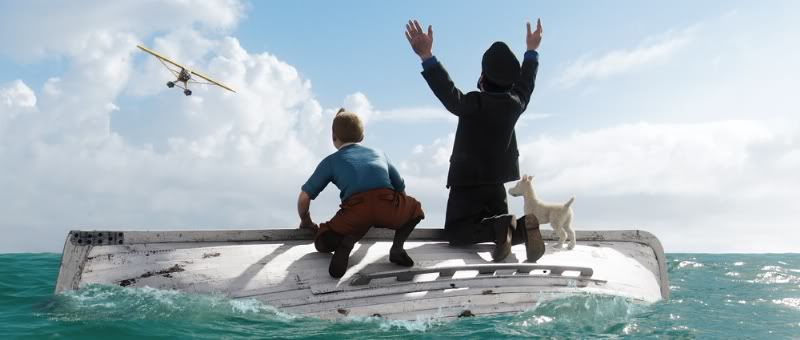

By Mike Wilmington Wilmington@moviecitynews.com
Wilmington on Movies: The Adventures of Tintin
All this exciting fast-motion cinematic action-painting is rendered in motion-capture, the real-life-to-animation process Robert Zemeckis used in The Polar Express and A Christmas Carol to meld a weird realism with dazzling visual technique. I actually don’t like motion-capture or performance-capture much — I think it makes the characters look strangely stiff and lifeless, like animated waxworks — but though I didn’t think the movie was a complete success, it certainly held my attention. It also made me eager to sample a Tintin tome or two. (Roger Ebert, who was introduced to the world of Tintin at a long-ago Cannes Film Festival, apparently has all of them.)

Herge wrote and drew the strip for 54 years, beginning in Le Petit Vingtieme the youth section of a right wing Catholic Belgian newspaper, starting in 1929, when he was 22 or so, and continuing until his death in 1983. Herge put the stories in their own magazine in the ‘40s and eventually made them into 24 book-length Tales — “graphic novels,“ before their heyday — and one unfinished fragment.
All of them became wildly popular throughout Europe, but not, for some reason, in the U.S. As an inveterate prowler of book stores and libraries, and a self-professed sucker for stuff like this, I can testify that never in all my years of adventure-and-book searching — which began one night years ago, when, as a tot, I took a Tarzan book home from the local library — have I ever seen a Tintin book in a bookstore or library. Nor, in fact, had I ever heard of Tintin (whom I probably would have figured was one of Rin Tin Tin’s pups), before this movie was announced. And in Europe, he‘s a giant of comics, books, TV, movies, action toys (I bet), t-shirts, you name it.
This movie — a longtime labor of love for Herge buffs Spielberg and producer Peter Jackson — was assembled out of three Tintin tales from the 1940s: “The Crab With the Golden Claws,” “The Secret of the Unicorn” and “Red Rackham’s Treasure” (but not the long-lost, probably apocryphal Swedish sequel, “The Girl With the Golden Crab Tattoo”). The two chmpion filmmakers plan to favor us with even more Tintin, a trilogy’s worth, with the next one to be directed by Jackson, if this one is a success.
I hope it is. I’d like to walk into a bookstore sometime and find a Tintin staring at me. A lot of them are on Amazon, but I havent seen any on bookstore bookshelves. Or anything else mostly, since I ceased my own daily bookstore visits when the local Borders died,
Those original Herge-drawn comics were done in a style called “Ligne Claire” (or “clear line“), a two dimensional, ultra-simple black outline technique usually used for simple children‘s funny comics like Ernie Bushmiller‘s Nancy (and Sluggo) — or maybe like the color-filled line drawings Jean and Laurent de Brunhoff made for the French “Babar” picture books (which were popular stateside).
Spielberg’s Tintin movie doesn’t use anything like a clear line, except in the sharp-edged credits illustrations. And it may be that Spielberg and Jackson have made something of a miscalculation here, in Spielberging and Jacksonizing the visuals too much: in translating the Tintin stories into the somewhat dead-eyed “realism” of motion-capture along with the eye-filling virtuosity of the usual Spielberg action set-pieces. The charm of Herge’s comics probably lay in their mix of a child’s simple-line world and the kind of heavily detailed action adventure scenarios that comic strip artists like Milton Caniff usually drew, imbuing their panels with far more realism and detail than Herge’.
I suspect the movie would work better if it had actually been done in something closer to the Ligne Claire style — maybe like the wonderful recent French Kirikou cartoons by Michel Ocelot. But that’s a different arena, a different financial ball game.
Then again, though I really don’t like most motion-capture, and the lifelessness it often endows on its characters, maybe Spielberg was right to use more complex images. Certainly you couldn’t have gotten anything approaching this movie’s great chase scene in any approximation of Ligne Claire, and that’s the movie‘s unbeatable showpiece,
The script — by Steve Moffat, Edgar Wright (Shaun of the Dead) and Joe Cornish (Attack fhe Block) — is a little thin and, I thought, light on wit. It pales next to the usual Pixar script, and I really wouldn’t have guessed that going in. But the voice actors are fine (primarily Bell, Serkis, Craig, and Simon Pegg and Nick Frost as Thompson and Thomson, the bearded detective twins), and the Spielberg team (editor Michael Kahn and composer John Williams) make their usual perfect-business-as-usual contributions. Though I thought he put more soul into War Horse, Spielberg is clearly very engaged with this material, and invigorated by it, even though sometimes it seems to run away with him.
Meanwhile, I say bring on the Tintin books, all 23 or 24 of them. Kindle ‘em, bindle ‘em, whatever you want. Vive le Ligne Claire! I like visual virtuosity, and Spielberg’s and Jackson’s brand as much as anyone’s. And all those jillions of European Tintin fans had some reason to love this plucky boy scout of a detective/journalist hero, with his moxie and his pointy hair quiff. And Snowy too, of course.
















Tintin books were in my pubic library in the 1960’s.They were long,boring stories and a pale rip off of little Orphan Annie.
@ kendallterry
Unfortunately the majority of the world doesn’t agree with you.